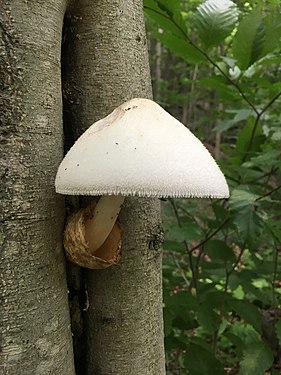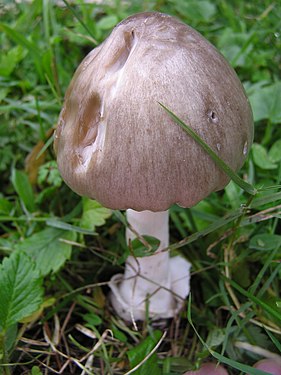

In mycology, a volva is a cup-like structure at the base of a mushroom that is a remnant of the universal veil,[1] or the remains of the peridium that encloses the immature fruit bodies of gasteroid fungi.[2] This macrofeature is important in wild mushroom identification because it is an easily observed, taxonomically significant feature that frequently signifies a member of Amanitaceae. This has particular importance due to the disproportionately high number of deadly poisonous species contained within that family.
A mushroom's volva is often partially or completely buried in the ground, and therefore care must be taken to check for its presence when identifying mushrooms.[3] Cutting or pulling mushrooms and attempting to identify them later without having noted this feature could be a fatal error.
Whilst a volva is a feature best known from Amanita species and stinkhorns such as the Phallaceae family and others in the Phallales order, it may also occur with other genera including:
Some other species such as Leucoagaricus volvatus, Leucoagaricus bivelatus also display a volva despite this not being a typical trait for these genera.[4]
The majority of the almost 300 species described In the Conocybe genus do not have a volva but there are a small number of species in Conocybe section Singerella which possess a small volva, though in some it may not be immediately evident as they can remain buried in dung. Conocybe species with a volva include: C. anthuriae,[5] C. corneri,[6] C hornana,[5] C. locellina,[5] C. vaginata,[7] C. volvata,[8] C. volviornata,[9] C. volviradicata.[10]
-
Volvariella surrecta growing parasitically
References[edit]
- ^ Kirk PM, Cannon PF, Minter DW, Stalpers JA (2008). Dictionary of the Fungi (10th ed.). Wallingford, UK: CAB International. p. 727. ISBN 978-0-85199-826-8.
- ^ Miller HR, Miller OK (1988). Gasteromycetes: Morphological and Developmental Features, with Keys to the Orders, Families, and Genera. Eureka, California: Mad River Press. p. 133. ISBN 0-916422-74-7.
- ^ Kuo M. (2007). 100 Edible Mushrooms. Ann Arbor, Michigan: The University of Michigan Press. p. 45. ISBN 978-0-472-03126-9.
- ^ Akers, Brian P.; Ovrebo, Clark L. (2005). "Leucoagaricus bivelatus, a new volvate leptoid species". Mycotaxon. 91: 303–308.
- ^ a b c Watling, Roy; Hausknecht, Anton (1997). "Conocybe anthuriae, a new volvate species from Mauritius (Africa)" (PDF). Österreichische Zeitschrift für Pilzkunde. 6.
- ^ Watling, Roy (1979). "Observations on the Bolbitiaceae XVII Volvate Species of Conocybe" (PDF). Sydowia Beihefte. 8: 401–415.
- ^ Watling, Roy (1979). "Observations on the Bolbitiaceae XVII Volvate Species of Conocybe" (PDF). Sydowia Beihefte. 8: 401–415.
- ^ Agretious Thomas, K.; Hausknecht, Anton; Manimohan, P. (2001). "Bolbitiaceae of Kerala State, India: New species and new and noteworthy records" (PDF). Österreichische Zeitschrift für Pilzkunde. 10: 87–114.
- ^ Horak, Egon; Hausknecht, Anton; Desjardin, Dennis E. (2002). "Notes on extra-European taxa of Bolbitiaceae (Agaricales, Basidiomycota)" (PDF). Österreichische Zeitschrift für Pilzkunde. 11: 226.
- ^ Watling, Roy; Işiloğlu, Mustafa; Sermenli, Hayrünisa Baş (2011-02-11). "Observations on the Bolbitiaceae 31. Conocybe volviradicata sp. nov". Mycotaxon. 114 (1): 145–149. doi:10.5248/114.145.


